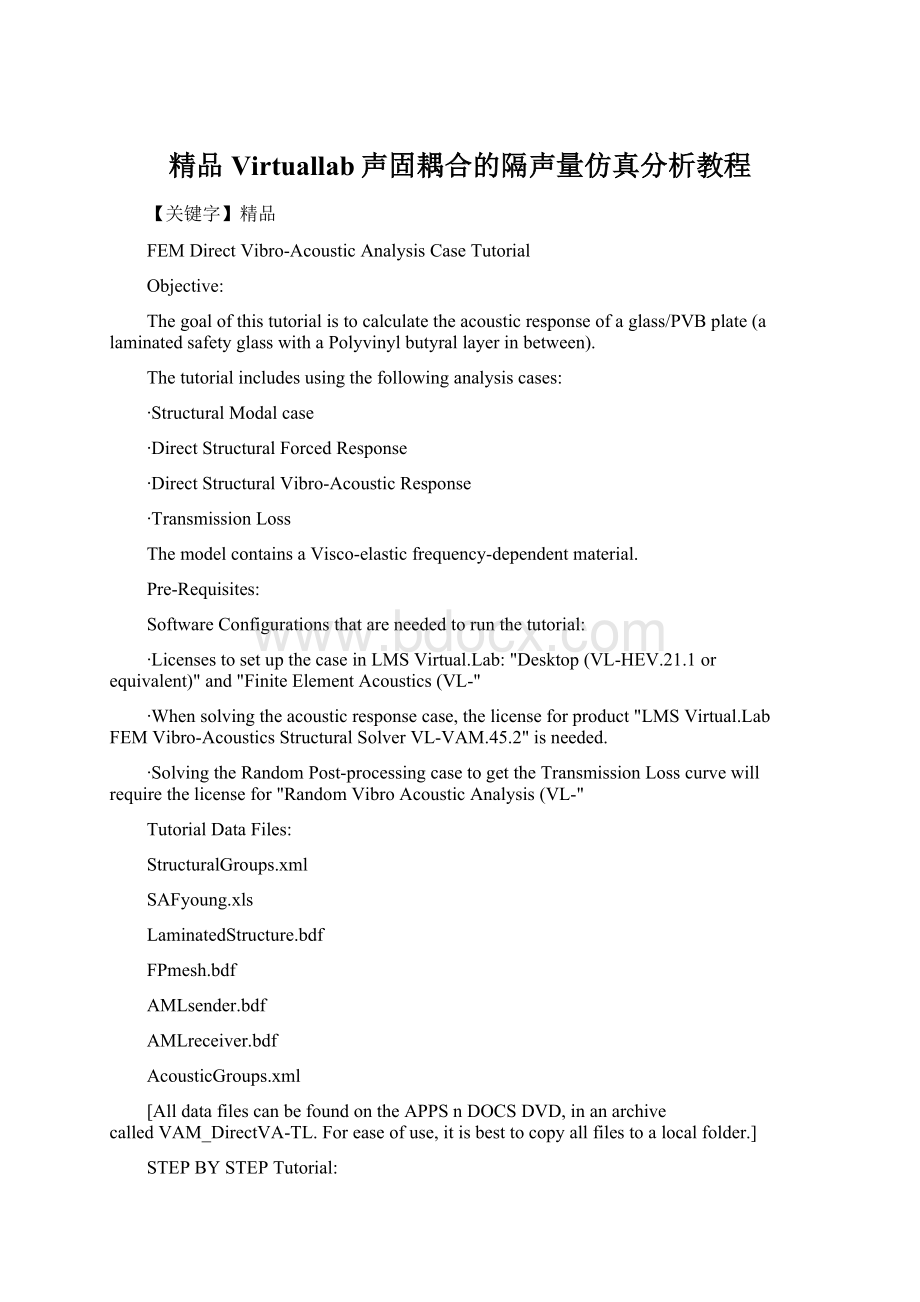 精品Virtuallab声固耦合的隔声量仿真分析教程.docx
精品Virtuallab声固耦合的隔声量仿真分析教程.docx
- 文档编号:7601442
- 上传时间:2023-01-25
- 格式:DOCX
- 页数:12
- 大小:29.84KB
精品Virtuallab声固耦合的隔声量仿真分析教程.docx
《精品Virtuallab声固耦合的隔声量仿真分析教程.docx》由会员分享,可在线阅读,更多相关《精品Virtuallab声固耦合的隔声量仿真分析教程.docx(12页珍藏版)》请在冰豆网上搜索。

精品Virtuallab声固耦合的隔声量仿真分析教程
【关键字】精品
FEMDirectVibro-AcousticAnalysisCaseTutorial
Objective:
Thegoalofthistutorialistocalculatetheacousticresponseofaglass/PVBplate(alaminatedsafetyglasswithaPolyvinylbutyrallayerinbetween).
Thetutorialincludesusingthefollowinganalysiscases:
∙StructuralModalcase
∙DirectStructuralForcedResponse
∙DirectStructuralVibro-AcousticResponse
∙TransmissionLoss
The modelcontainsaVisco-elasticfrequency-dependentmaterial.
Pre-Requisites:
SoftwareConfigurationsthatareneededtorunthetutorial:
∙LicensestosetupthecaseinLMSVirtual.Lab:
"Desktop(VL-HEV.21.1orequivalent)"and"FiniteElementAcoustics(VL-"
∙Whensolvingtheacousticresponsecase,thelicenseforproduct"LMSVirtual.LabFEMVibro-AcousticsStructuralSolverVL-VAM.45.2"isneeded.
∙SolvingtheRandomPost-processingcasetogettheTransmissionLosscurvewillrequirethelicensefor"RandomVibroAcousticAnalysis(VL-"
TutorialDataFiles:
StructuralGroups.xml
SAFyoung.xls
LaminatedStructure.bdf
FPmesh.bdf
AMLsender.bdf
AMLreceiver.bdf
AcousticGroups.xml
[AlldatafilescanbefoundontheAPPSnDOCSDVD,inanarchivecalled VAM_DirectVA-TL.Foreaseofuse,itisbesttocopyallfilestoalocalfolder.]
STEPBYSTEPTutorial:
STEP1
AfterstartingLMSVirtual.Lab,createanewdocumentintheAcousticHarmonicFEMWorkbench(Start
Acoustics
AcousticHarmonicFEM).
STEP2
SelectFile
Importfromthemainmenu.[TheImportcommandcanalsobeselectedfromthecontextualmenuoftheLinksManager,byrightclicking]
Afileselectorwindowappearsallowingyoutospecifythefiletypeandthefilename.[Formoredetails,seeImportingData]
SelectthefiletypeNASTRANBulkFile(*.bdf,*.NS,*.nas,*.dat)andbrowseforthefileLaminatedStructure.bdfandclicktheOpenbutton.Anewdialogboxappearsrequestingtheselectionofdatathatneedstobeimportedfromthefile.Thedataentriesthatarenotavailableinthefilearegrayedout.
SelectinSplitintoMultipleMeshPartsunderMeshCreationandsettheunitsystemtoMeter,Kilogram,Second,clicktheOKbutton.
STEP3
Next,thedifferentstructuralmaterialswillbedefined.ThetwoouterlayersofthepanelaremadeofGlass.Toincorporatethe2%structuraldampingofthismaterial,itwillbemodeledasaviscoelasticmaterialwithaconstantcomplexYoungmodulus.TheinnerlayerismadeofPVB.
Insert
Materials
NewMaterials
NewViscoelasticMaterial...
[Right-clickontheMaterialsfeatureintheSpecificationTree
NewMaterials
NewViscoelasticMaterial]
Definethematerialsasfollows:
GLASS
PVB
YoungModulus
Constant
PoissonRatio
MassDensity
YoungModulus
PoissonRatio
MassDensity
Real
Imaginary
0.23
2500kg_m3
FrequencyDependent
0.49
1066kg_m3
7.15e+011N_m2
1.401e+009N_m2
ThePVBmaterialatthecenterofthewindshieldhasstrongfrequencydependentstiffnesspropertiesandisnearlyincompressible.Thefrequencydependencycanbeincorporatedinaviscoelasticmaterialusinganeditedloadfunction.ThevaluescanbeimportedfromtheExceldocumentSAFyoung.xlsasfollows:
CheckFrequencyDependent,andright-clicktheinputfield.
SelectNewFunction.
IntheAttributestab,enterasNameYoung’smodulusPVB.
IntheValuestab,clicktheImportafilebutton,andbrowsetotheexcelfiletoselectit.
SwitchtheDataFormattoLinearAmplitude/Phase(deg)becausethefilecontainsthevalueslikethat.ClicktheImportbutton.
ClicktheOKbuttonoftheFunctionEditorGUI.
ClicktheOKbuttonontheMaterialGUI.
OntheEditedLoadFunctionSet,create(usingthecontextmenu)a2DdisplayoftypeComplex(EditedLoadFunction)ontheYoung’smodulusandcheckthecurve:
STEP4
DefiningtwoStructural3DpropertiesforGlassandPVB,appliedtothestructuralgroupsGlass(withthedefinedmaterialGlass)andPVB(withthedefinedmaterialPVB).
Insert
Properties
NewStructuralProperties
Create3D-Property
[Right-clickonthePropertiesfeatureintheSpecificationTree
NewStructuralProperties
Create3D-Property]
BeforethefollowingstepspleasemakesuretheMeshPartsaredefinedastypes:
PROPERTY0–Structural
Glass–Structural
PVB–Structural
ThiscanbedonebygoingtoTools
SetMeshPartsType
[Right-clickonthemeshintheSpecificationTree,SetMeshPartType
SetasStructuralMeshPart]
STEP5
Inthenextstep,themodelmeshwillbeimportedfromtwoNastraninputfiles.TheyeachcontainameshonwhichwewillapplyanAMLproperty(AutomaticallyMatchedLayer),oneonthereceiverside,andoneonthesenderside.:
File
ImportAcousticMesh
ModelMesh...,andselectthefileAMLreceiver.bdf
UseMeter,KilogramandSecondsunits,andincludethematerialsandproperties.
Similarly,importAMLsender.bdf.
Atthispointthemeshpartstypedefinitionwindowshouldlooklikethis:
STEP6
InsertingtheNewMaterialandpropertiesforthenewimportedmeshes
InsertanewAcousticmaterialasfollows(usethedefaultvaluesforair):
InsertalsoaNewFluidProperty.Callitalsoair,usethejustdefined material'Air',andapplyittothetwoAcousticmeshparts(SenderandReceiverside).
STEP7
Tofacilitatethecreationofthestructuralandacousticmodel,someelementgroupshavebeenpredefinedinxmlfiles.Toimportthesegroups,firstcreatemeshgroupsets.
InsertaNewGroupSet,eitherfromthecontextualmenuorwith Insert
MeshGrouping
GroupSet....
ByrightclickingtheGroupSetfeatureintheSpecificationTree,insertameshgroupnamedStructuralGroups,andinitimportthe5groupsfromthefileStructuralGroups.xml.
Right-clicktheGroupSet,anduseMeshGrouping
GroupSelectionDialog…:
SimilarlyinsertameshgroupnamedAcousticGroups,andinitimportthe4groupsfromthefileAcousticGroups.xml
Right-clickthegroupset,anduseagain MeshGrouping
GroupSelectionDialog…:
Step8
Savetheanalysis,butwithoutclosing.
SETTINGUPTHEACOUSTICCASES
Step1
Insertanewacousticautomaticallymatchedlayerpropertytotakeintoaccountthesemi-infiniteextentofthesenderandreceiverrooms.InsertanewAMLpropertybyright-clickingProperties,useNewAcousticProperties
AutomaticallyMatchedLayerProperty....
ApplyittothetwoAcousticgroupsAMLReceiverandAMLSender.SwitchtheRadiationsurfacetoUserDefined,andselecttheAMLReceivergroup.
Step2
InsertaDirectVibro-AcousticResponseAnalysisCasetocomputethestructuralresponseandacousticpressurefieldsinboththesenderandreceiveracousticdomainsforeachofthedistributedplanewaveexcitations:
ToperformthiscalculationuseNoLoadfunctionSetandNoLoadVectorSet.
Createnewsetsforalltherest.
STEP3
ExpandtheDirectVibro-AcousticResponseAnalysisCasefromtheSpecificationTree,right-clicktheBoundaryConditionSetanduseAcousticSources
DistributedPlaneWaves...withaRefinementLevelof2,aRadiusof4m,andanAcousticPressureon1Pa.Theplanewaveswillbeusedtoexcitethesystemandtocalculatethetransmissionlosscharacteristicsofthepanel.
Sincethepanelisnotalignedwiththexyplane,thiscoordinateplanecannotbeusedtodefinethelocationoftheplanewavesources.So,fortheHalfSpacePlaneselectPlanedefinedbyGroupandselecttheacousticgroupCouplingSender.
SelecttheNegativeHalfSpaceside.
ClicktheOKbuttontogenerateasetof12spatiallydistributedplanewaves.
Bynowthemodelshouldlooksimilartothis:
Step4
Wewillnowrestraintheborderoftheglasspanel.
Right-clicktheRestraintSet,addanAdvancedRestraintonthe3TranslationalDOFs,anduseassupporttheStructuralGroupBCs.
Step5
Couplingsurfacedefinitionwillbeusedtocoupletheupperandlowersurfacesofthepaneltotheenvelopesurfaceoftheacousticcavity.WhensettingtheCouplingSurface,thecouplingbetweenthestructureandthefluidisonbothsides.
Tocorrectlydefinethetwo-sidedcouplinginatransmissionlosscalculation,twocouplingsurfacesneedtobecreated.FromtheCouplingSurfaceSet.1feature,double-clicktheCouplingSurfaceSet.1,andaddthetwo surfaces:
StructuralGroupCouplingSenderandAcousticGroupCouplingSender.Useatoleranceof10mmandselectasCouplingTypeOneside.ClicktheApplybutton.
DothesamefortheReceiverSideintheendyoushouldhavetwoCouplingsurfaces:
Step6
Double-clickontheDirectVibro-AcousticResponsesolutiontoupdatetheanalysisparameters.Inthecurrenttutorial,theresponseatthecenterfrequenciesofthethirdoctavebandsbetween160Hzand2000Hzwillbeanalyzed.IntheResultSpecificationstab,selectUserDefinedvaluesfortheArgumentAxisDefinitionandremovethestandardanalysisfrequencyrange.AddanewfrequencyrangedefinitionandselectaLogarithmicStepdefinitionwithastartingfrequencyof160Hz,anendingfrequencyof2000Hzandastepof1.8.ClicktheOKbuttontoaddthefrequencyrangedefinition.
RequestVectorresultsatFieldPointsandfortheAcousticPotentials.NoneedtosolveforStructuralDisplacementsfornow.
AdjusttheSolvingParameters.Ifyoursystemissetupforparallelprocessing(seetheAdvancedAcousticInstallationmanual),tryoneoftheParallelismtypes.UsetheDirectsolver.
AdjustalsotheJobandResources,e.g.tousemultiplethreads.
LeavetheOutputSetsempty,meaningthatresultswillbecomputedwhereverpossible.
Step7
UpdatetheDirectVibro-AcousticResponseSolutiontocomputetheacousticpressurefieldsandstructuraldeformations.Thiswilltakeawhile,asthereare23frequenciesand12loadconditions.Saveyourmodel.
Step8
- 配套讲稿:
如PPT文件的首页显示word图标,表示该PPT已包含配套word讲稿。双击word图标可打开word文档。
- 特殊限制:
部分文档作品中含有的国旗、国徽等图片,仅作为作品整体效果示例展示,禁止商用。设计者仅对作品中独创性部分享有著作权。
- 关 键 词:
- 精品 Virtuallab 耦合 隔声量 仿真 分析 教程
 冰豆网所有资源均是用户自行上传分享,仅供网友学习交流,未经上传用户书面授权,请勿作他用。
冰豆网所有资源均是用户自行上传分享,仅供网友学习交流,未经上传用户书面授权,请勿作他用。


 铝散热器项目年度预算报告.docx
铝散热器项目年度预算报告.docx
